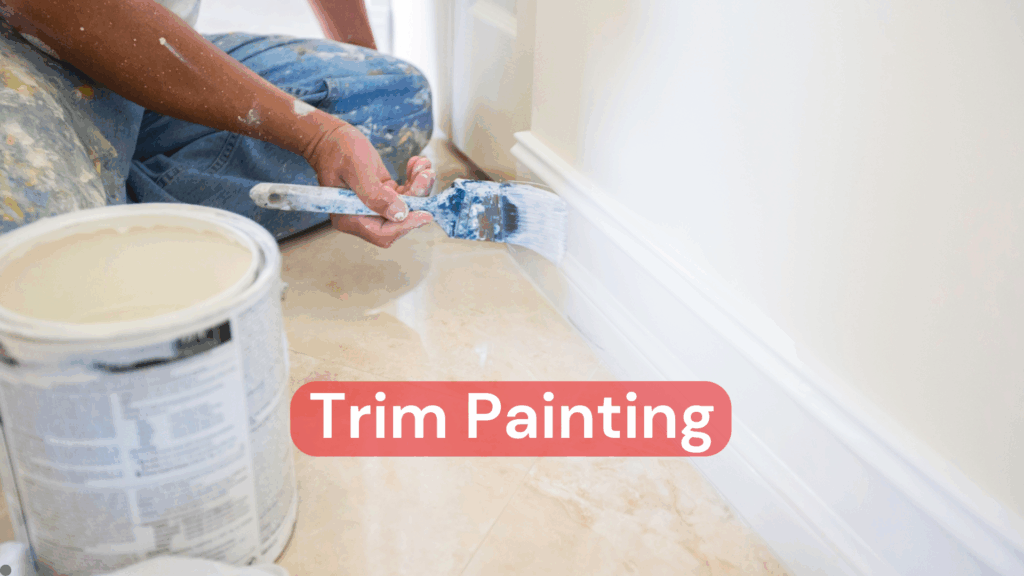Not many people enjoy trim painting, but we do! In this article we provide clear steps, paint tips, and advice on when to call a pro for those crisp lines.

Trim flaws can ruin an otherwise perfect paint job. One misplaced brush stroke, a drip that dried before you caught it, or edges that bleed onto the wall can undermine weeks of careful work. The walls might look great, but the trim tells a different story. Brush marks catch the light. The edges are uneven. This is what happens when trim painting goes wrong.
Trim painting isn’t just another weekend project. It’s a detail-driven task that requires patience, precision, and the right approach. Get it right, and your rooms look polished and complete. Get it wrong, and every imperfection becomes obvious. The trim frames your entire space, which means mistakes don’t hide.
Table of Contents
The Impact of Trim Painting on Your Home’s Aesthetics
Trim defines the edges of your space. It separates walls from floors, frames doors and windows, and adds architectural interest. When painted well, it creates clean lines that make rooms feel finished and intentional.
The colour and condition of your trim sets the tone for everything else. White trim against coloured walls creates contrast. Dark trim adds drama and depth. But regardless of your colour choice, the execution matters more than anything.
Crisp, clean lines signal quality. They show that someone took the time to do things right. Sloppy trim work does the opposite. It draws attention to flaws and makes the entire room look unfinished, even if the walls are perfect.
The finish matters too. Trim typically needs a different sheen than walls because it gets touched more often and needs to withstand wear. A consistent finish across all trim in your home creates visual harmony. Inconsistent finishes make rooms feel disconnected and poorly maintained.
Prep Work Essentials: Creating a Solid Foundation
The difference between amateur and professional trim work shows up in the preparation. Most people want to skip straight to painting. That’s where things go wrong.
Start by cleaning every surface. Dust, grease, and grime prevent paint from adhering properly. Use a damp cloth or mild cleaner to remove buildup. Pay attention to baseboards near floors where dirt accumulates.
Sanding comes next. Light sanding with 120-grit sandpaper smooths out old brush strokes, removes paint drips, and creates a surface that accepts new paint. Skip this step and every imperfection from previous paint jobs will show through.
Your preparation phase determines the quality of your final results. From cleaning and sanding to priming. It might seem like extra steps, but this makes all the difference between a pro and a DIY painter.
Fill gaps and cracks with caulk or wood filler. Trim shifts over time, creating small gaps where it meets walls or where pieces join together. These gaps stand out once you apply fresh paint. Caulking these areas before painting creates seamless transitions.
Primer matters, especially if you’re changing colours or painting bare wood. It seals the surface, covers stains, and helps the topcoat adhere. Don’t skip it. After priming, sand again lightly to remove any brush marks or drips before applying your final coats.
Protect your walls and floors. Drop cloths prevent spills. Painter’s tape creates boundaries, though applying it properly takes skill. Press the tape down firmly and run a putty knife along the edge to seal it. Otherwise, paint seeps underneath.
Tools and Techniques for Crisp, Clean Trim Painting
The right tools make a significant difference. A high-quality angled brush gives you control for precise work. Cheap brushes shed bristles and leave streaks. Invest in a good one.
Cutting in requires a steady hand and practice. This technique involves painting freehand along edges where trim meets walls. Use a Cut In Paintbrush or Triangle Paintbrush as recommended by Zibra. Hold your brush like a pencil, close to the bristles for better control. Load the brush with paint but not too much. Apply steady pressure and move slowly.
Apply thin coats rather than thick ones. Thick paint drips and leaves brush marks. Thin coats dry faster and look smoother. You’ll need multiple coats anyway, so build up coverage gradually.
Don’t overwork the paint. Once you’ve applied it, leave it alone. Going back over areas that have started to dry creates texture and unevenness. This is one of the most common painting mistakes people make.
Work in good lighting. You need to see what you’re doing. Natural light works best, but if you’re painting in the evening, use bright work lights to catch drips and missed spots.
Choosing the Right Paint and Finish
Trim paint differs from wall paint in important ways. It needs more durability because trim gets bumped, touched, and cleaned more often than walls.
Sheen selection matters. Most professionals recommend semi-gloss or satin for trim. These finishes resist wear better than flat or eggshell paints. They’re also easier to clean. Semi-gloss reflects more light and highlights imperfections, so your prep work needs to be thorough. Satin offers a softer look while still providing durability.
Match your trim finish to your wall finish appropriately. A common approach is to go two levels higher on trim than walls. If your walls are flat, step up to satin on trim. From eggshell walls, move to semi-gloss for a durable, cleanable finish. Higher sheen paints provide more durability and shine (Sherwin-Williams). This creates visual interest and practical benefits.
Quality matters more for trim than walls. Premium paints flow better, level out more smoothly, and provide better coverage. They’re worth the extra cost for trim work because the results last longer and look better. As covered in our guide to paint quality, better paint means better coverage and fewer headaches.
Consider the colour carefully. Changing trim colour later requires more work than repainting walls, so choose thoughtfully from the start.
Why Hiring a Pro Makes All the Difference
Trim painting is much more complicated than painting walls because precision matters so much. A small area means every mistake shows. Permanent brush marks and uneven lines can’t be hidden.
Professional painters bring refined techniques developed over years of practice. They know how to prep properly, which products work best, and how to achieve smooth, consistent results. They also work faster because they’ve done it thousands of times.
Professionals offer several key advantages:
- Expertise and Skill
- Time and Efficiency
- Proper Equipment and Materials
- Cost-Effectiveness
- Professional Results
At Harding’s Painting, we’ve spent over 25 years perfecting our approach to trim work across Calgary, Kelowna, Edmonton, and Hamilton. We understand that trim painting can make or break a room’s appearance. Our team handles the tedious prep work, uses professional-grade materials, and delivers the crisp lines that define quality work.
Professionals also carry insurance and have the right equipment. Painting high trim or working around stairs requires proper ladders and safety measures. We handle these challenges daily, so you don’t have to worry about the risks.
The time savings alone justify hiring professionals for many homeowners. What might take you an entire weekend (or longer) takes our experienced team a fraction of the time. You avoid the frustration of learning through mistakes and the cost of fixing errors.
Our interior painting services include detailed trim work as part of a complete approach to transforming your space. We coordinate colours, finishes, and timing to minimize disruption to your life.
Achieve Professional Results with Expert Trim Painting
Trim painting defines the quality of your interior spaces. It’s the difference between a room that looks professionally finished and one that looks DIY. The details matter, and this task demands attention to those details.
If you’re considering tackling trim painting yourself, understand what you’re getting into. The prep work is extensive. The technique requires practice. The results depend on patience and precision. Many homeowners start the project and quickly realize why professionals charge what they do.
For those ready to transform their homes without the stress, Harding’s Painting offers free quotes. We’ll assess your trim, discuss your goals, and provide a clear plan for achieving the polished look you want. Our team handles everything from prep to final coat, delivering results that last.
Your trim deserves the same attention as any other element of your home. Done right, it frames your spaces beautifully and adds lasting value. Done poorly, it becomes a constant reminder of shortcuts taken. Choose the approach that matches your goals and skill level, but remember that some tasks benefit from professional expertise.



